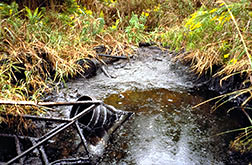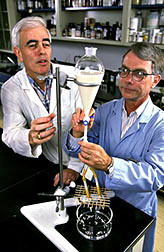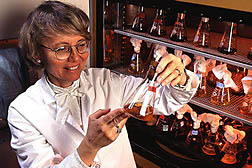Microbes Clean Up Toxic Waste
 Polluted area at Old Inger, an abandoned petroleum refinery, where a massive spill occurred in 1981. (K7574-2) |
A microbiology doctoral student sporting protective boots and gloves trudged through Old Inger, the site of an abandoned petroleum refinery in Darrow, Louisiana. He had special clearance from state environmental authorities to take soil samples there because Old Inger was named a federal superfund site in 1981. That means that pollution at the site was so extensive it qualified for special government funds to help clean it up. In the case of Old Inger, one of the problems was benzo[a]pyrene, a carcinogen.
In some parts of Old Inger, weeds and trees are reclaiming the land; but in other parts, thick, black sludge remains. That day, something in a leaf pile caught Ken Wunch's eye—a light-tan mushroom about an inch-tall, of a species known as Marasmiellus troyanus.
Wunch took the mushroom back to Tulane University in New Orleans, Louisiana, where another doctoral candidate, Toby Feibelman, cultured the fungus and got surprising results: The mushroom broke down benzo[a]pyrene better than anything tried before in their laboratory.
"We tested the Marasmiellus against Phanerochaete chrysosporium, formerly considered the "hot" fungus for breaking down benzo[a]pyrene," says Wunch. "When we checked how it did, the Marasmiellus had decomposed all but 10 percent of the contaminant, while the other fungus left 67 percent."
The 1993 finding was big news—especially for Wunch’s mentor, molecular mycologist Joan W. Bennett.
Feibelman has since followed Professor Bennett’s early career path, also doing postdoctoral research at ARS’ Southern Regional Research Center (SRRC) in New Orleans. Bennett still keeps her ARS ties, working with chemists William J. Connick, Jr., and Donald J. Daigle on new formulation systems to deliver these helpful microorganisms—referred to as bioremediators—to clean up pollution.
“It’s an example of technology transfer at its best,” Bennett says. “Bill and Don are formulating living microorganisms in products that can be applied in farmers’ fields to control weeds and insects.
“While biological controls and bioremediation differ, the need for reliable formulations is the same.”
 Alginate gel beads made by ARS chemists Don Daigle (left) and Bill Connick contain a fungus that can convert toxic chemicals to harmless ones. (K7572-6) |
“The right formula will make the fungus multiply,” says Connick, “and that will allow us to spread it over a greater distance. With an extra food source, we can turn nature’s odds in our favor. We also make the process economical, so growers—and industry—will want to try the technology.”
The product standards for a biological control for pests or a bioremediator for pollution are high. The goal is to keep the beneficial organisms viable for 2 years at room temperature, so that unused product can be stored and used in the following growing season.
Storage requirements reflect the needs of potential users. Barns and storage bins tend to be hot and humid in summer—not the best conditions for preserving microorganisms. But refrigeration—which can prolong shelf life—is too expensive. And farmers and companies want products they can store over winter without viability losses, keeping overhead down.
Bioremediation got its first major publicity when ocean bacteria were harnessed to help clean Alaskan waters after the Exxon Valdez oil spill.
Now not only ARS, but more universities are supporting this kind of work. Bennett, for example, receives funding from the Tulane-Xavier Center for Bioenvironmental Research. But finding new bioremediators isn't easy. Some organisms may break pollutants down into something equally toxic, so pretesting is a must.
Bennett's first bioremediation project with Connick and Daigle involved Phanerochaete chrysosporium, commonly known as the white rot fungus.
As Wunch mentioned, P. chrysosporium was considered the "gold standard" for breaking down benzo[a]pyrene. Other scientific literature, some going back to the 1960's, shows that the fungus has the capacity to decompose everything from paper to now-banned pesticides such as DDT.
“These fungi have enzymes to break down lignin, which is a tough material in wood. They tear down the lignin in order to get to their food supply,” says Bennett. “But as it turns out, their enzymes are highly nonspecific. They can break down organic toxins, leaving other harmless compounds that other microorganisms use as food.”
 Tulane University molecular mycologist Joan Bennett examines a fungus that can degrade TNT (trinitrotoluene) in liquid culture. (K7571-4) |
Bennett wants to use the fungus’ might against residues left from munitions production.
The Cold War’s end brought closure for many weapons plants, but toxic souvenirs such as TNT (trinitrotoluene) remain.
Medical literature shows it can cause liver damage and anemia. TNT poisons a host of other life forms, including fish, algae—and some kinds of fungi. But if P. chrysosporium proves to be effective, it might help turn back the clock for these former weapon-production sites.
Part of its chances for success rests on finding the appropriate formulation. It’s a task tailor-made for the two ARS researchers who have already developed several for biocontrol of weeds.
“We’ve also developed pretty extensive research protocols, allowing us to create formulas for a variety of organisms. We try to optimize acidity, nutrition, temperature, moisture, and a host of other conditions to stabilize a biological control product,” Connick says.
Opening what looks like a refrigerator in the Connick/Daigle laboratory reveals a house cleaner’s nightmare—molds, fungi, and bacteria happily thriving in various growth mediums, creating a pungent smell.
They could be living in alginate (derived from kelp), a formulation technology that Connick helped develop, or in wheat-based Pesta granules he co-invented for encapsulating living biocontrol agents. Some microorganisms will be growing in agricultural byproducts left over from processing midsouth commodities such as sugar, rice, or cotton. That midsouth connection stems from the SRRC’s focus on crops of that region.
And don’t be surprised if the scientists’ “refrigerator” blows warm air. That’s because it’s an incubator designed to mimic warm conditions at those barns and clean-up sites. The experiments were designed to indicate product shelf life.
“We modified this Tupperware container so it has an inner shelf to hold small beakers of samples,” says Daigle, bringing out one of the incubator’s contents.
“See the small amount of water on the bottom? It contains specific salts that allow us to control humidity levels.”
His year-long collaborative study with Bennett shows that white rot fungi prefer alginate over Pesta. But the work doesn’t stop here.
Alginate is more costly--and expense is an important factor in whether bioremediation gets used by industry. Connick and Daigle plan to look for cheaper options and may modify the Pesta formula so it appeals to the finicky fungus.
“Pesta formulations have shown great success with two really effective biological controls used to stop swamp dodder in cranberries,” says Daigle. “Maybe with white rot fungus we used too much wheat flour. We’ll be looking at a lot of things to see if Pesta can’t be adjusted to work with white rot, too.”
And while Connick and Daigle are busy with that project, they’ll also be getting ready for their newest guest--that mushroom survivor from Old Inger. — By Jill Lee, ARS.
Donald J. Daigle is in the USDA ARS Southern Regional Research Center, New Orleans, LA; phone (504) 286-4211.
This page last updated June 2005.






